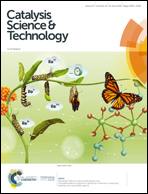The role of speciation of Ni2+ and its interaction with the support for selectivity and stability in the conversion of ethylene to propene†
Abstract
Different kinds of Ni2+ species ranging from isolated sites to nanostructured NiO and Ni silicate or Ni aluminate were prepared on the surface of silica, alumina, and silica–alumina by grafting, incipient wetness impregnation and template-ion exchange methods. The nature of surface NiOx species was elucidated on the basis of characterisation by UV-vis spectroscopy, XRD, FTIR spectroscopy of adsorbed carbon monoxide and temperature-programmed reduction with hydrogen. The acidity of both the supports and the catalysts was studied by FTIR spectroscopy of adsorbed pyridine. The amount and nature of coke formed on the catalysts during the reaction were determined by temperature-programmed oxidation. The highest propene selectivity of 40% at an ethylene conversion of 50% and the lowest selectivity to coke were obtained over the catalyst possessing highly dispersed or even isolated NiOx sites connected to Al3+ in the silica–alumina support. The propene selectivity over this catalyst is higher than that achieved over the state-of-the-art Ni/AlMCM-41 catalyst prepared by a complicated template-ion exchange procedure. Ni2+ supported on silica, even when prepared by grafting, suffers from low propene selectivity due to severe coke production directly from ethylene. Thus NiOx bound to Si is not well-suited for ethylene reaction to propene. Ni2+ grafted on alumina is less active and selective due to formation of surface Ni aluminate.



 Please wait while we load your content...
Please wait while we load your content...